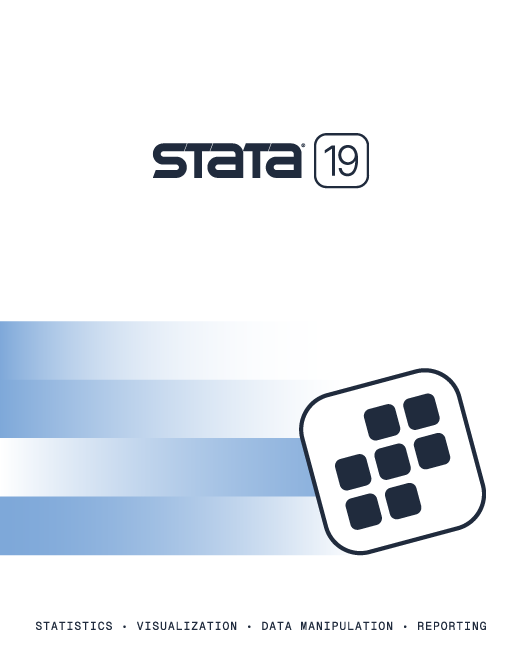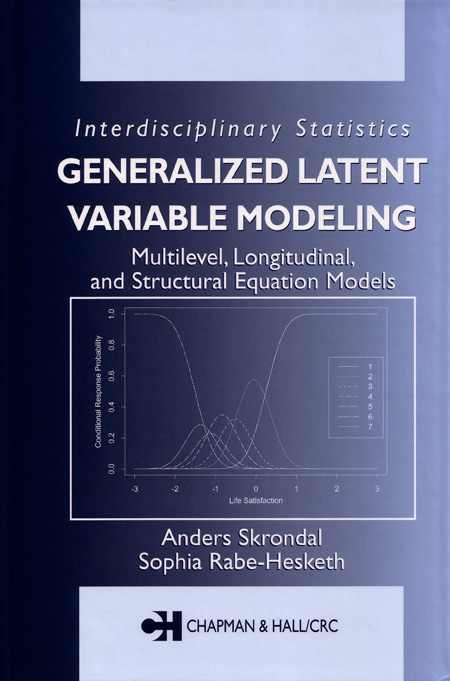

2025 Stata Conference • Nashville, TN • 31 July–01 August
Generalized Latent Variable Modeling: Multilevel, Longitudinal, and Structural Equation Models |
||||||||||||||||||||||||||||||||||||||
 Click to enlarge See the back cover |

As an Amazon Associate, StataCorp earns a small referral credit from
qualifying purchases made from affiliate links on our site.
eBook not available for this title
eBook not available for this title |
Review of this book from the Stata Journal
|
||||||||||||||||||||||||||||||||||||
Comment from the Stata technical groupThis text unifies the principles behind latent variable modeling, which includes multilevel, longitudinal, and structural equation models, as well as generalized mixed models, random coefficient models, item response models, factor models, panel models, repeated-measures models, latent-class models, and frailty models. Since latent-variable models are used by researchers from various disciplines with little or no cross-referencing from other disciplines, unifying these models allows readers to separate what the authors refer to as local jargon from the fundamental elements of these models. As such, this text allows readers to gain quick and easy access to models and estimation schemes that have long existed in other disciplines but perhaps are not widely used in their own. The book consists of two main parts: methodology and applications. Chapters 1–4 provide background information and generalized development of latent variable models. Chapters 5–8 are concerned with techniques of estimation, prediction, and inference. Chapters 9–14 comprise the applications portion of the text, and here the unification from chapters 1–4 is applied to case studies from various fields, including biostatistics, political science, social science, and econometrics. The models demonstrated in the applications section are fitted using the Stata program gllamm, written by the authors of this text and available from www.gllamm.org. |
||||||||||||||||||||||||||||||||||||||
Table of contentsView table of contents >> Preface
Dedication
I Methodology
1 The omni-presence of latent variables
1.1 Introduction
1.2 ‘True’ variable measured with error 1.3 Hypothetical constructs 1.4 Unobserved heterogeneity 1.5 Missing values and counterfactual s 1.6 Latent responses 1.7 Generating flexible distributions 1.8 Combining information 1.9 Summary 2 Modeling different response processes
2.1 Introduction
2.2 Generalized linear models 2.3 Extensions of generalized linear models 2.4 Latent response formulation 2.5 Modeling durations or survival 2.6 Summary and further reading 3 Classical latent variable models
3.1 Introduction
3.2 Multilevel regression models 3.3 Factor models and item response models 3.4 Latent class models 3.5 Structural equation models with latent variables 3.6 Longitudinal models 3.7 Summary and further reading 4 General model framework
4.1 Introduction
4.2 Response model 4.3 Structural model for the latent variables 4.4 Distribution of the disturbances 4.5 Parameter restrictions and fundamental parameters 4.6 Reduced form of the latent variables and linear predictor 4.7 Moment structure of the latent variables 4.8 Marginal moment structure of observed and latent response s 4.9 Reduced form distribution and likelihood 4.10 Reduced form parameters 4.11 Summary and further reading 5 Identification and equivalence
5.1 Introduction
5.2 Identification 5.3 Equivalence 5.4 Summary and further reading 6 Estimation
6.1 Introduction
6.2 Maximum likelihood: Closed form marginal likelihood 6.3 Maximum likelihood: Approximate marginal likelihood 6.4 Maximizing the likelihood 6.5 Nonparametric maximum likelihood estimation 6.6 Restricted/Residual maximum likelihood (REML) 6.7 Limited information methods 6.8 Maximum quasi-likelihood 6.9 Generalized Estimating Equations (GEE ) 6.10 Fixed effects methods 6.11 Bayesian methods 6.12 Summary Appendix: Some software and references 7 Assigning values to latent variables
7.1 Introduction
7.2 Posterior distribution s 7.3 Empirical Bayes (EB) 7.4 Empirical Bayes modal (EBM) 7.5 Maximum likelihood 7.6 Relating the scoring methods in the `linear case' 7.7 Ad hoc scoring methods 7.8 Some uses of latent scoring and classification 7.9 Summary and further reading Appendix: Some software 8 Model specification and inference
8.1 Introduction
8.2 Statistical modeling 8.3 Inference (likelihood based) 8.4 Model selection: Relative fit criteria 8.5 Model adequacy: Global absolute fit criteria 8.6 Model diagnostics: Local absolute fit criteria 8.7 Summary and further reading II Applications
9 Dichotomous responses
9.1 Introduction
9.2 Respiratory infection in children: A random intercept model 9.3 Diagnosis of myocardial infarction: A latent class model 9.4 Arithmetic reasoning: Item response models 9.5 Nicotine gum and smoking cessation: A meta-analysis 9.6 Wives' employment transitions: Markov models with unobserved heterogeneity 9.7 Counting snowshoe hares: Capture-recapture models with heterogeneity 9.8 Attitudes to abortion: A multilevel item response model 9.9 Summary and further reading 10 Ordinal responses
10.1 Introduction
10.2 Cluster randomized trial of sex education: Latent growth curve model 10.3 Political efficacy: Factor dimensionality and item-bias 10.4 Life satisfaction: Ordinal scaled probit factor models 10.5 Summary and further reading 11 Counts
11.1 Introduction
11.2 Prevention of faulty teeth in children: Modeling overdispersion 11.3 Treatment of epilepsy: A random coefficient model 11.4 Lip cancer in Scotland: Disease mapping 11.5 Summary and further reading 12 Durations and survival
12.1 Introduction
12.2 Modeling multiple events clustered duration data 12.3 Onset of smoking: Discrete time frailty models 12.4 Exercise and angina: Proportional hazards random effects and factor models 12.5 Summary and further reading 13 Comparative responses
13.1 Introduction
13.2 Heterogeneity and ‘Independence from Irrelevant Alternatives’ 13.3 Model structure 13.4 British general elections: Multilevel models for discrete choice and rankings 13.5 Post-materialism: A latent class model for rankings 13.6 Consumer preferences for coffee makers: A conjoint choice model 13.7 Summary and further reading 14 Multiple processes and mixed responses
14.1 Introduction
14.2 Diet and heart disease: A covariate measurement error model 14.3 Herpes and cervical cancer: A latent class covariate measurement error model for a case-control study 14.4 Job training and depression: A complier average causal effect model 14.5 Physician advice and drinking: An endogenous treatment model 14.6 Treatment of liver cirrhosis: A joint survival and marker model 14.7 Summary and further reading References
Index
Author index
|
||||||||||||||||||||||||||||||||||||||
Learn
Free webinars
NetCourses
Classroom and web training
Organizational training
Video tutorials
Third-party courses
Web resources
Teaching with Stata
© Copyright 1996–2025 StataCorp LLC. All rights reserved.
×
We use cookies to ensure that we give you the best experience on our website—to enhance site navigation, to analyze usage, and to assist in our marketing efforts. By continuing to use our site, you consent to the storing of cookies on your device and agree to delivery of content, including web fonts and JavaScript, from third party web services.
Cookie Settings
Last updated: 16 November 2022
StataCorp LLC (StataCorp) strives to provide our users with exceptional products and services. To do so, we must collect personal information from you. This information is necessary to conduct business with our existing and potential customers. We collect and use this information only where we may legally do so. This policy explains what personal information we collect, how we use it, and what rights you have to that information.
These cookies are essential for our website to function and do not store any personally identifiable information. These cookies cannot be disabled.
This website uses cookies to provide you with a better user experience. A cookie is a small piece of data our website stores on a site visitor's hard drive and accesses each time you visit so we can improve your access to our site, better understand how you use our site, and serve you content that may be of interest to you. For instance, we store a cookie when you log in to our shopping cart so that we can maintain your shopping cart should you not complete checkout. These cookies do not directly store your personal information, but they do support the ability to uniquely identify your internet browser and device.
Please note: Clearing your browser cookies at any time will undo preferences saved here. The option selected here will apply only to the device you are currently using.